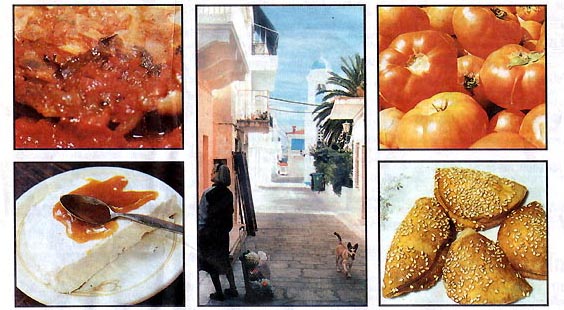
|
LAST month, my husband and I went to Tinos to try and sell our post-Mediavel house in the village of Falatados. It was late, we were starving, and we decided to ask the kind lady who runs the local kafeneio, if there was anything to eat. She was so sorry and so apologetic in her helplessness that we felt uneasy and a little embarrassed for having asked. Just as we reached the door, she told us softly that she could of course make us a few eggs in any way we liked and give us a tomato and cucumber salad, but she understood how inadequate such a meal may be for people who came from the capital. We rushed to assure her that her proposal was more than adequate, and we sat down, to some splendid fresh bread, a piece of goat’s cheese and a jug of local retsina to wait for the main
When this came, we blessed the lateness of the hour that made us stop at the local café for a meal. Neither of us had eaten such delicious eggs for years. The tomatoes had nothing in common with the wet, coloured cardboard-like spheres that we taste when we buy them either at the local street market or at health food stores. The fact that the latter sell organic products says nothing about the taste of these products. If you start with a tasteless tomato, organic cultivation will make it safer to eat, but not necessarily tastier. The tomatoes we were served were simply heavenly. And so was every other thing we ate and drank that evening. From the early travellers, such as the Frenchman Jacob Spon and the Englishman George Wheeler, who visited the island in 1675-76, we hear that Tinos had the largest population and the best cultivated lands of all the Cycladic islands. Similar remarks were made the French academician Pitton de Tournefort, around 1700, adding that the island’s principal source of wealth was its silk, exported mainly to France. A little later, the Frenchman Charles de Saint Maure (around 1721) praised the silk embroideries and the fine stockings for ladies, while fifty years later another Frenchman, Cloiseul-Gouffier, praised the beauty of Tinian women, who do know how to cover but do not know how to hide their beauty. Similar observations were made by a German, Johann Hermann von Riedesel, a few years earlier, who adds that the Tinians were the smartest and the most cultivated of all Greek islanders. All this is reflected in facts, such as that the island had 67 villages until earlier last century (now there are only 46), and that during the 1821 revolution, which resulted in Greek independence, the taxes assessed to Tinians show them to be the wealthiest of the islanders. The beautiful dovecotes (peristerones) that grace most villages of Tinos furnish a continuous supply of excellent organic manure used by the tillers of the land in their cultivation, and this ensures the production of organic products. Unlike many other Cycladic islands, Tinos is still largely unspoiled by the tourist trade. Only around the middle of August, crowds of Greek pilgrims arrive on the island for the celebration of the feast of the Virgin (Megalohari) on the 15th of the month. This sudden influx strains the resources of the island to the utmost, but the Tinians have found ways of coping with and profiting from the annual ritual. Tinos is a movable feast, as Hemingway would say, and in every village of the island seek out the small, unprepossessing restaurant or café, and have something to eat and drink there. Chances are you will leave the place enchanted with the local tastes and the friendliness, kindness and hospitality of the people. Recipes Potato pie (Patatou) (Serves 8-10) 2 ½ kilos small potatoes 1 large onion, finely chopped 1 tbs butter 1 cup grated Kefalotiri cheese 4 eggs, slightly beaten ½ cup milk ½ cup crushed rusk ½ cup parsley, finely chopped 1 tsp oregano 1 tsp nutmeg salt, pepper to taste 2 tbs olive oil Wash the potatoes and boil with their skins. When cold peel and mash with a potato masher. Saute the onion in 1 tablespoon butter and allow to cool. Put the potatoes and onion in a large bowl and mix with the cheese, eggs, milk, crushed rusk, finely chopped parsley and oregano. Combine well and add the nutmeg and salt and pepper to taste. Coat a baking pan (25x35cm) with butter. Spread the mixture, which should be quite thick, evenly. With a fork make a pattern of squares on the surface. Pour the oil over the top and bake in a 175C/350F oven for about 1 hour or until golden brown. Serve warm or cold with a green salad. Sweet cheese pie (Skepasti) 1 kilo Anthotiro cheese 6 eggs, slightly beaten 2 cups sugar ½ tsp ground mastic ½ tsp cinnamon 2 sheets shortcrust pastry (from the frozen section of the super market) Mix the first five ingredients well in a bowl. Coat a baking |
|

